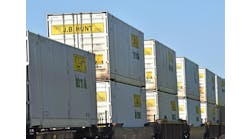Adding Value to Your Supply Chain: Seven Cardinal Sins to Avoid
Over the last decade, the expectation and focus on completing “perfect orders” has increased in the supply chain industry. From the product to its condition and even documentation, the demand for excellence involving all parts of the process has intensified. To maintain orders and improve the quality of business, organizations must have efficient supply chain solutions in place. When implementing new programs, it’s wise to assess supply chain models and procedures as an essential step to enhance service with suppliers, partners and customers.
Plenty of measures can be put in place to help companies operate at optimal levels. On the flip side, there are common “cardinal sins” that can add cost and time and damage brand reputation—these can and should be prevented in order to keep supply chain efficiency and customer satisfaction high.
Let’s take a closer look at seven sins of supply chain management and how to avoid them. In alphabetical order they are:
1. Back Order
Orders are usually placed on back order when a product is out of stock. Oftentimes, we don’t realize the effects back orders may have, such as threatening market share, profits, and customer satisfaction and loyalty. Supply chain technology applications should have the ability to adjust swiftly to include new locations, delivery methods and supplier networks to combat back orders as much as possible.
2. Deadheading
The return of an empty trailer that does not produce any revenue is called deadheading. From both a financial and environmental standpoint, this can be extremely wasteful. Factors including climate and inaccurate manifests may lead to deadheading, but with immediate, location-based data combined with a powerful network, it can be averted. Reduce deadheading and you can decrease transportation costs, carbon footprint and time delays. Proficient supply chains provide data and visibility across traditional network borders to identify opportunities to diminish deadheading.
3. Demurrage
Delayed returns of a carrier’s equipment beyond the allotted “free” time results in demurrage fees for shippers and consignees. Unfortunately, this occurs frequently throughout the supply chain; the fines and lost time can add up to high costs for an organization—in more ways than one. Flexible supply chain solutions give shippers, forwarders and third-party logistics providers (3PLs) the visibility needed to pinpoint problems and make modifications. Real-time positional data captured from satellite tracking systems, when integrated with technology solutions, also help to identify true causes of delays and which party in the supply chain holds responsibility.
4. Empty Repo
This refers to the movement or repositioning of empty containers—clearly an inefficient and costly process. What’s worse, the lack of visibility and tracking that contributes to empty repo can often “miss” available containers that are nearby. Managing the logistics of empty containers is challenging due to numerous persons being involved, import-export economies, seasonality and container types. Nevertheless, with a global trade network providing visibility, collaboration and timely communication, these challenges, along with costs, can be controlled.
5. Inaccurate Billing
When shipping documents misreport significant attributes of cargo, the resulting inaccurate or false billing can prompt additional carrier charges. Hindering the process of a “perfect order,” this violation impacts transportation arrangements as well. Modern-day supply chain software solutions help to thwart this expensive mistake through specific checks and balances built into the technology.
6. Inbound Ignorance
Delivering goods into a factory, distribution center, or retail location is a common point in the supply chain where inefficiencies can occur. Many operators allow this key step to be managed by suppliers without regard to costs and procedures performed. This is especially detrimental when shipping and handling fees are relied upon to recover margins that may have been bargained away in the price of the goods. Leveraging technology to control each leg of an order’s journey from supplier to end customer is a successful tactic to avoid this costly mistake.
7. Lack of Benchmarking:
Businesses may assume they have settled on good transportation rates; however, it’s important to validate the true value by benchmarking against others in the sector. Access to analytics and data enables companies to set benchmarks for a variety of KPIs and build an understanding of their position against competitors. Leading organizations are leveraging providers that gather data across industries to create anonymized benchmarks not only for competitive comparison, but also to identify opportunities for cost improvement. These insights can also help decrease activities that don’t add value.
Every day, organizations are looking to enhance the efficiency of their supply chains and business operations while adjusting to market pressures. In this fast-paced environment, it’s important to integrate technologies that offer visibility and analytics across systems. For example, cloud technology allows for flexibility, fast integration of tools, pay-as-you-go services, automatic and regular upgrades, and updated security measures. As a result, organizations will see improvement in the overall speed and integration of the supply chain.
Paired with cloud-based solutions, a global trade network (GTN) supply chain model can generate more advantages for businesses. The GTN links carriers, shippers, forwarders, suppliers and customers through one cloud-based platform. These network members are able to access data in real-time, helping them to avoid committing the aforementioned “deadly sins” while gaining a competitive edge.
The supply chain is evolving more rapidly than ever before. It’s vital that organizations eliminate common offenses to deliver the greatest value at every point and maintain high quality and customer service. “Perfection” is a tall order, but a truly optimized supply chain is attainable with connected technology bolstered by a modern collaborative network.
Doug Surrett is chief product strategist for BluJay Solutions, a provider of supply chain software and services, where he oversees the company’s product convergence and expansion strategy. He has been in the logistics industry since 1988, serving in leadership roles focused on transportation management, warehouse management, operations and global trade.



